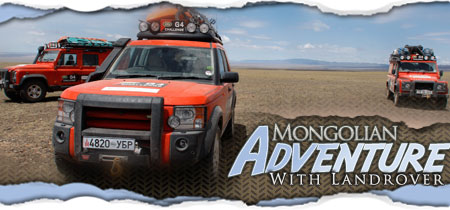
A Four-Wheeling Expedition Through Mongolia
By Sue Mead
Air currents bounced our Korean jet’s approach to Mongolia’s capital city, Ulaanbaatar. Below us, it seemed as if rivers served as Mongolia’s only paintbrush for the vast expanses of people-less arid steppes; undulating, fawn-colored sand dunes; and the vast, monochromatic rocky plains, once ruled by Genghis Khan.
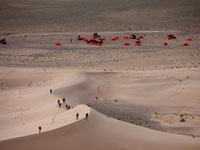 |
Mongolia's sparse desert landscape is just one of the country's many terrains. |
This is exactly how I remembered this isolated land from a month-long, adventure expedition with Land Rover, in 1997. For more than a decade, I had held the memories of this unique country in my heart, as the place I wanted to revisit the most of all the places I have traveled. My work as a motor journalist has taken me to 64 countries, some many times and, yet, Mongolia had held the greatest allure of all because of its widely diverse landscapes, the time-warp quality of travel once outside of its capital city, and the small numbers of visitors who put Mongolia on their ‘bucket list’.
Although quickly growing in popularity, particularly among adventure travelers, this nation sees as many visitors over the course of a year as Disney World’s Magic Kingdom sees in a week.
Touching down in UB-the capital’s nickname- where over a million of this nation’s 2.8 million people reside is like entering a time portal between two disparate realities. This is only one of the reasons why Land Rover’s 2009 G4 Challenge here offers unique excitement, as UB is a 21st century city of concrete and metal that springs up like a frontier town, from an antiquated former Soviet Union infrastructure, that since the fall of the Iron Curtain is resurging with new Buddhist temples. During the era of communism, a systematic campaign destroyed many monasteries and temples; those left today offer visitors special images of iconic saddle roofs and traditional Buddhist symbols.
Another world starkly contrasts UB’s contemporary construction, and begins where the city’s modern-day periphery ends. Here, in felt-covered, circular gers--or yurts-- the traditional, moveable home of the Central Asian Steppe, is a large proportion of UB’s residents. But, as we traveled a short distance by small jet further to the largely-unpopulated countryside and the Gobi desert, we found the images of peaceful nomadic herdsmen that mirror the 13th century period, when Khan turned the horsemen of the steppes into a brutal band of warriors who grew an empire so vast it stretched from the Pacific Ocean to the plains of eastern Europe and most of Asia.
In 2009, this isolated land sandwiched between China and Russia will become home to the Land Rover G4 Challenge Finals Event --a grueling three-week-long, nation-versus-nation competition comprised of 18 two-person, male-female international teams. As the name implies, competitors will face many challenges in this land of continental climate, with bitterly cold winters, extremely hot summers, and minimal annual rain and snowfall.
It was up to the members of the Land Rover G4 Recce Team during a recent motoring jaunt in Mongolia to map routes in this remote land for the Challenge Finals. We joined the team to get an up-close look at this country and to try a few of the activities that will be used as competitive venues during the Challenge.
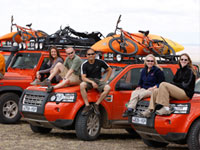 |
Land Rover 4 x 4s fully loaded and ready to embark on the Mongolian journey. |
In addition to navigating fully-loaded, expedition-prepared Land Rover 4 x 4s, each carrying a kayak and two bikes strapped to the roof up, over and around shifting sand dunes, craggy uneven plateaus and rough river beds that can shake the teeth out of your head, competitors’ acumen at sports other than skilled driving and navigation will also be tested during the G4 Finals. Competition vehicles are set up with a raised air intake; winch; rear ladder with step; lamp guards front and rear; roof rack with roof lamps; Goodyear MTR's; and an interior with a dog guard; and a fire extinguisher.
Part of our job was to find picturesque and tough off-road driving routes that will give the competitors the opportunity to compete in kayaking events; mountain biking trials– and squeeze their toes into sharp cliff faces, as climbing skills are also part of this extreme sports venue, along with other sport challenges. In addition, the Competition Team, a squad of multi-skilled, highly-capable drivers and athletes that are trained in emergency wilderness medicine, was scouting for campsites that can accommodate up to 150 participants, without serious impact on the environment. Land Rover is a founding member of Tread Lightly, the land ethics organization that sets responsible guidelines for off roading, camping and other back country activities.
We found the Mongolian terrain a strange, almost ethereal mixture of land formations, populated by inhabitants that are often colorfully dressed and share a rich history. It is called Land of the Blue Sky because its clear heavens enjoy over 250 sunny days a year. Cerulean mirages are common.
This land of serene contrasts is made up of mountain forests in the north near the Soviet Siberian border; windswept arid steppes extending from one horizon to the other in the central plains (steppes and meadows cover about 52-percent of the Mongolian grounds); as well as rings of jagged mountains, the spectacular “flaming red cliffs” with its enormous cache of dinosaur bones; ice flows; and the famed Gobi -- an immense territory of desert and semi-desert that extends across the Chinese border in the south that is home to endangered wild camels and snow leopards.
The Gobi is the world’s fourth-largest desert, but actually has few sand dunes – only 3-percent of the total land mass. The Khongoryn Els, which means singing dunes, is the name given to the enchanting swirls of sand found in this unique landscape. Undulating some 656 feet skyward, when wild winds twirl these mesmerizing formations, melodious sounds are made that can be heard miles away. Winches will hold one hundred feet of coiled and braided cable mounted on the front of each competitor’s Land Rover, a crucial aid for Land Rover G4 Challenge team members, who need to winch their vehicle out of the shifting sands.
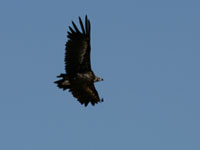 |
An old world Vulture on of few animals found in the Land of the Blue Sky |
The Land Rover G4 Competition Team and their Recce staff are prepared to adventure through some of the harshest erratic weather on the planet, motoring its fleet of 4WD SUV's past a host of rare plant and animal species, while hoping to glimpse some endangered ones, such as the snow leopard and the wild Bactrian camel. As we caravanned across the semi-arid desert of southern Mongolia toward the spectacular, dinosaur-bones rich flaming reddish orange cliffs in Bayanzag, first discovered by Roy Chapman Andrews – the real Indiana Jones -- we could see, the Three Beauties in the distance- the East, Middle and West sub-ranges of the Gurvansaikhan Mountains. Within this range is the Gurvansaikhan National Park, located at the eastern end of the stunning Altai mountains.
Yolyn Am, or Valley of the Eagles, is found in the Eastern Beauty region of Mongolia, and has been a protected site since 1965. The Three Beauties are the East, Middle and West sub-ranges of the Gurvansaikhan Mountains, where Gurvansaikhan National Park is located, at the eastern end of the stunning Altai Mountains. The name “yol” is ironic, as it translates to lammergeier, which means Old World vulture. This is a bearded- not bald-bird that has a 49-inch long body and 10-foot wing span that appeared large enough to carry away members of the Land Rover G4 Recce Team.
We were traveling through an area of the Gobi Desert with little precipitation, where Yolyn Am’s steep cliffs narrow down to a riverbed passageway so small that each vehicle had to be guided through to avoid the sharp protrusions of the ledges. Wintertime fills this gorge with a deep ice field measuring over six-feet high and several miles long lasting until early fall, that has never entirely melted. The reward for perseverance was breath-taking views of an expansive valley that greeted us when we finally emerged.
It is easy to understand why Mongolia is called Land of Blue Sky, as it was often the most dominant color above the sand-stone colored terrain, during our travel. Mastering sand driving, using the technology employed by Land Rover’s all-terrain response system, was a thrill and it brought us to a location that made us feel like the only living things on the planet.
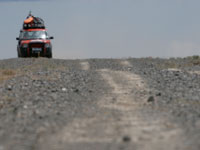 |
Land Rover's treck across the sparsely populated Mongolian countryside. |
The Gobi, one of the world's largest deserts, is also one of the highest, with elevations averaging 5,183 feet. It often appears like a wasteland of uninhabitable gravel plains and gnarled stone outcrops. However, we knew we could easily encounter a wide variety of wildlife, including mountain sheep, wild donkey, black tail gazelles, ibex, lynx, saiga antelope, and the mazaalai or a Gobi bear. Wolves and the steppe fox also live in Mongolia among the blue khargana plants, beautiful pink tamarisk shrubs, red trees, and wild thyme that bring intense hues to the steppes and arid plains, where the earth yields deposits of precious and semi-precious stones such as turquoise, jasper and crystal.
Our first and last nights of the off-road adventure were spent in four-person gers -- primitive structures constructed of round wooden felt-covered frames -- which work to keep out the elements. We also ate dinner under the stars, slept in nylon tents and told tales around a camp fire, in this land that is still quite primitive, but is changing to keep up with the modern-day world.
In an effort to wean the nomadic peoples-- who are spread out in 14 provinces, called aimags—from using pollution-causing, habitat-destroying fossil fuels, the government, along with the help of international aid agencies, is providing Mongolia’s nomads with small solar panels or wind turbines. Black & Veatch, a U.S.-based global engineering, consulting and construction company, also recently announced it is conducting an environmental and social impact assessment on a potential 50-megawatt wind farm site approximately 40 miles from Ulaanbaatar, a city that is modern-day and frontier-town both and is filled with a rich history.
Today, a nod to that history is found in the Parliament Building in the centrally located Soviet-style plaza, where a commanding new bronze statue sits in honor of the revered Genghis Khan, who founded Mongolia. The square is named for Sükhbaatar, a Mongolian military leader of the 1921 revolution that helped free Mongolia from China.
Surrounded by four sacred mountains, UB is nestled on the southern end of the Khentii Mountains in the valley of the Bogd Mountains, between the rivers of Tuul and Selbe. It was founded as a true city in 1639, but moved numerous times until finally settling into its present location in 1778. The name Ulaanbaatar, translated as ‘Red Hero’, was bestowed in 1924 to commemorate Mongolia’s liberation from foreign rule, although it was under the rule of the Communist government until the late 90s.
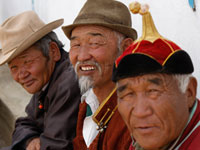 |
Mongolian natives live in a traditional world that is slowly being westernized. |
UB offers something for lovers of history, science, culture, sports and entertainment, everything from museums to ancient Buddhist monasteries and festivals. Exhibitions at the Natural History Museum include two remarkable whole skeletons of tarsauborus and saurolophus dinosaurs, as well as fossilized nests. Museums and private collections around the world are sprinkled with discoveries found in the Gobi. A plethora of fossilized dinosaur bones and eggs have been found and studied, which have almost brought to life the extinct species that populated the steppes 700 million years ago.
The highlight of Mongolian life today, however, is the summer Naadam Festival. This National Public Holiday combines three major traditional sports: archery, wrestling, and horse racing. Unbelievably, riders as young as four and five years old ride compete, as many learn to ride horses at an early age, in order to help with the chores of nomadic life. The Nadaam existed for centuries as a religious celebration honoring different mountain gods. Today it helps commemorate the 1921 revolution to political independence and includes folklore performance of gaily costumed natives engaging in ethnic dances, traditional folk song, throat singing and music of the horse fiddle.
With its history of fierce competitions, its unique and hauntingly-beautiful landscape, along with fantastic four wheeling Mongolia makes a perfect destination for the 2009 Land Rover G4 Finals and others, who eschew Disney’s Magic Kingdom for the vast open, and unpopulated spaces still left to explore..
Fast Facts:
Mongolia:
When arriving at a traditional Ger, a visitor will say "nokhoi khorioroi", which means "call off the dog" – and should not carry a whip or weapon when entering.
“Ta sain baina uu?” means "how are you?" or "how do you do?"
Remote Mongols tend not to shake hands with visitors, but greet by stretching their arms out wide.
Mongolia is home to the globally endangered Snow Leopard as well as 136 mammals, almost 400 different birds and 76 species of fish.
Mongolia secured final independence from China in 1921 and had a democratic reform in 1990, when there was a shift from dependence on the former Soviet Union.
The country is split into 21 aimags (provinces) which are subdivided into 298 sums (districts).
The population of Mongolia is around 2.6 million (based on UN World Population Prospects: The 2007 Revision) with an estimated two thirds of people below 30 years of age.
Ulaanbaatar houses around 700,000 inhabitants – a major portion of the urban population still
live in Gers on the outskirts of town.
The official language is Khalka Mongolian, spoken by around 75 percent of the population.
CURRENCY
The currency in Mongolia is the Tughrik (or Tugrug or MNT). Approximate conversation rates:
British Pound 1 GBP = 2,275 MNT
Euro 1 € = 1,800 MNT
US Dollar 1 US$ = 1,160 MNT
Do's and Don’ts
- DO receive food or drink with your right hand and use the left hand to support the right elbow.
- DO sleep with your feet pointing towards the door.
- DO NOT whistle inside a Ger, or point a knife towards anyone, even when cutting food.
- DO NOT put water or rubbish on a fire – it is sacred to Mongolians.
- DO NOT write anything in red pen.
- When offered vodka, dip your right ring finger into the glass and flick three drops – to the sky, the wind and the ground – then drink or, if you don't want any, put the same finger to your
forehead.
IF YOU GO |
For more information on Mongolia, Genghis Khan and the region’s history and culture visit:
Mongolia Tourism |
|